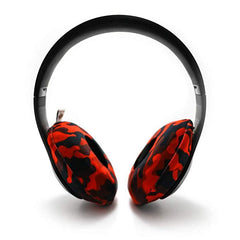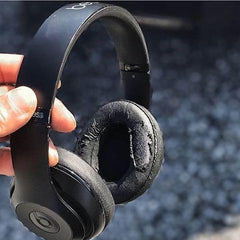Why Do Headphones Hurt My Ears?
Headphones can be split into three categories: over-ear, on-ear and in-earphones.
It’s pretty self-explanatory; the cushion on over-ear headphones sits OVER the ear, on-ears press ON the ear and in-earphones fit INSIDE the ear.
When buying headphones it can sometimes be difficult to know which is the most comfortable to wear. If you’re buying a premium brand like Bose or Sony, then you might be surprised to hear that even those headphones can hurt your ears. You can easily judge technology and design but comfort is more individual and harder to discern especially if you’re buying from a brand that’s new to you or if you’re buying off the internet.
Why Do Headphones Hurt My Ears?
Check the Size Before You Buy
Headphones that are too small will hurt your ears. You should check the width of the headband before purchasing as one that’s too tight which be uncomfortable and painful. You might not have considered the size of your head before but everyone’s melon is different. Don’t assume that one-size-fits-all because it doesn't. You should check the size of the cups, too, because if you have especially large or small ears then you may find some models a poor fit. If the cushions are too big or too small, then they can’t sit against the ear properly and the pressure on the ear’s cartilage will be uncomfortable.
When you buy in-earphones, it’s useful to keep the small packet of replacement buds in a safe place. Often these include a smaller and larger size that may fit your ears more comfortably. It’s particularly difficult with in-earphones as everyone’s ear canal is different and what fits for one person won’t necessarily fit the next. Manufacturers make sizing and shape decisions based on what they think will fit the most people but as anyone who struggles to keep in-earphones and earbuds will tell you, one size definitely does not fit all.
You May Have Listener Fatigue
Listener fatigue is a feeling of tiredness that can occur after a prolonged period of listening to sound. According to Alex Rowe, it’s often related to “too much energy in the higher frequencies” and this can be down to the way a headphone is designed or our own individual sensitivity. Sony describes listener fatigue as something that happens when your eardrums are working too hard to process loud volume flowing through the ear canal and putting a big strain on the eardrum. Listener fatigue is only going to go away by taking a break and taking your headphones off.
Are You Wearing Glasses?
If the headphone is pressing down on the arm of your glasses, then this can cause significant discomfort over time. If you wear contact lenses and glasses, then it could be worth swapping to contacts whenever you’re going to be wearing your headphones for extended periods. Glasses with thinner arms are better than thicker as less pressure is placed on the side of the head. The glasses that you presently own might not be suitable to wear with headphones and you may want to bear this in mind next time you purchase new ones.
Clamping Effect of On-Ear Headphones
It’s the clamping effect of headphones that keep them securely on our heads and ears because without it they’d slide right of. For those of us who wear headphones during exercise, the clamping effect is a big plus-point. It allows us to move around vigorously without having to keep readjusting. If the clamping effect is too strong, however, then it can become uncomfortable and painful as clamping puts pressure on the temporal bone as well as on the cartilage of the ear. One way of reducing how much ‘clamping’ force a headphone has is to stretch the headphones over a row of books or over the box they came in. Gently does it. After all, you don’t want to overstretch them and you still need the clamping effect to keep the cans on your head. This should add a little ‘give’ and make them fit more comfortably.
There’s Damage on Your Cushions
Headphone cushions are designed to be robust yet comfortable but if you’re not taking correct care of them then they can begin to crack and peel. The biggest reason for this happening is sweat damage. Sweat is corrosive. Not only will this look unsightly but it’s going to smell pretty bad, too. It’s also going to make the cushions uncomfortable against the ear. You have a few options depending on the type of headphone you’re wearing. One would be to buy a replacement pair of cushions. There are a number of third-party sellers on Amazon and eBay. You can also add sweat-proof headphone covers that will protect your cushions from moisture damage.
Wearing On-Ear and Over-Ear headphones in the Winter
Our ears can get very cold in the winter. There’s no fat on them for a start and when the temperature drops, the body reduces blood flow to our extremities in order to keep our vital organs warm. Cold ears aren’t just uncomfortable but they can be painful, too, and if you stick two cups over them, then they’re probably going to start hurting. You can add earmuff covers to headphones to help keep your ears teddy bear soft whilst still enjoying your playlists, podcasts and albums.
Why Do Noise Cancelling Headphones Hurt My Ears?
Some people just don’t seem to be able to get on with wearing active noise-cancelling headphones (ANC). We wrote about this in a previous post looking at whether noise-cancelling headphones were safe to wear. We concluded that they’re safe but that some people had reported sensitivity to the effects of the active noise-cancelling technology. This could be due to the soundwaves emitted by ANC cans to counteract incoming ambient noise. One study looked into whether the headphones had been a contributing factor in one woman’s onset of vertigo-like symptoms after wearing a pair for 12 hours. It’s possible that for some people ANC headphones simulate a kind of motion sickness. The Point Chaser blog writes about a personal experience of feeling pain and dizziness from wearing the Bose QC 35 II headphones. It points to a Reddit thread, too, of numerous users reporting ear pain and discomfort after wearing ANC headphones.
- There are a few things you can do, therefore, to reduce how much headphones hurt your ears.
- Where possible try before you buy to make sure they fit comfortably. Check the size, too, before purchasing.
- Take breaks from listening every so often.
- Turn the volume down if you’ve ramped it up.
- Keep the cushions in good shape by replacing wrecked ones and then adding a sweat-proof headphone cover.
- If your ears are prone to the cold, then add an earmuff headphone cover.
What’s your secret to keeping your ears comfortable during long periods of headphone use? Drop us a comment below.






